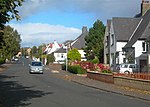Roman Catholic Diocese of Galloway

The Diocese of Galloway (Latin: Dioecesis Candidae Casae o Gallovidianus) is a Latin Church ecclesiastical territory or diocese of the Catholic Church in Scotland. The pre-Reformation Diocese of Galloway, founded by Ninian in the fifth century, had broken allegiance with Rome in 1560, and disappeared in 1689 in the (official) Church of Scotland but continued in the Episcopal Church of Scotland. The modern Roman Catholic diocese incorporates the local authority areas of Dumfries and Galloway, South Ayrshire, East Ayrshire and parts of North Ayrshire, (Cumbrae). The bishop's cathedra is at St Margaret's Cathedral, Ayr. The diocese was re-established by the Catholic Church on 4 March 1878, with its cathedral in Dumfries and its territory covering the sparse and rural counties of Dumfriesshire, Kirkcudbrightshire, Wigtownshire and parts of Ayrshire. Following the reorganisation of the Archdiocese of Glasgow in 1947, parishes to the north of Galloway were transferred to it from Glasgow, creating a significant population centre for the first time around the town of Ayr. In response to this development Bishop McGee moved his residence from Dumfries to Ayr, and following a catastrophic fire at St Andrew's Cathedral in May 1962, it was decided that the Good Shepherd Church, Ayr should also become the diocesan cathedral. The third and present cathedral, following the closure of Good Shepherd Cathedral in May 2007, is St Margaret's Cathedral in Ayr. The eighth and most recent bishop of the diocese was William Nolan, since 2022 the Archbishop of Glasgow.
Excerpt from the Wikipedia article Roman Catholic Diocese of Galloway (License: CC BY-SA 3.0, Authors, Images).Roman Catholic Diocese of Galloway
Corsehill Road,
Geographical coordinates (GPS) Address Nearby Places Show on map
Geographical coordinates (GPS)
| Latitude | Longitude |
|---|---|
| N 55.44868 ° | E -4.63039 ° |
Address
Corsehill Road
Corsehill Road
KA7 2ST , St Leonards
Scotland, United Kingdom
Open on Google Maps





